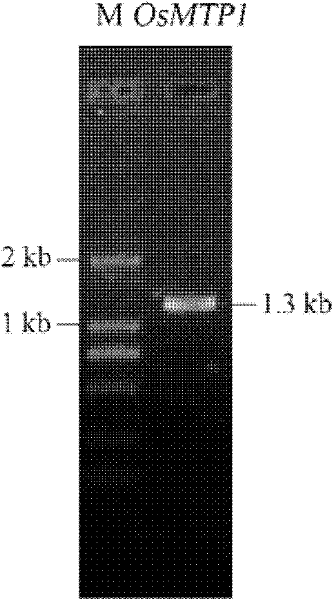Rice Metal Tolerance Protein osmpt1 and its Encoding Gene and RNA Interference Fragment
An RNA interference, metal technology, applied in the direction of DNA/RNA fragment, genetic engineering, plant genetic improvement, etc., can solve the problem of low expression, and achieve the effect of reducing food safety hazards
- Summary
- Abstract
- Description
- Claims
- Application Information
AI Technical Summary
Problems solved by technology
Method used
Image
Examples
Embodiment 1
[0026] Example 1: Cloning of the OsMTP1 gene
[0027] Take the seedling leaf parts of rice Nipponbare (seeds purchased from Guangdong Academy of Agricultural Sciences), extract total RNA from leaves with TriZol Reagent (Invitrogen Company, article number: 15596026), and detect total RNA by agarose gel electrophoresis and ultraviolet spectrophotometer Purity and quantity, take 1 μ g of total RNA to do the initial reverse transcription reaction, the reverse transcriptase used is MMLV (Pro omega company, its article number is: M1701), the step of reverse transcription reaction refers to the instructions for use of the reverse transcriptase . Use the reverse transcription product as a template and use primers:
[0028] 5'-CTCATCCCCAAGATGGACAGCC-3';
[0029] 5'-ACTACCTACCTGTCTCAAGCGGTCA-3' for conventional PCR amplification;
[0030] The PCR reaction system is: reverse transcription product 1μl, 10xBuffer 5μl, dNTP (each 2.5mM) 4μl, forward and direction primers (10μM) each 1μl,...
Embodiment 2
[0031] Example 2: Construction and genetic transformation of RNA interference vector of OsMTP1 gene
[0032] The interference vector used in the present invention is pTCK303 (A Practical Vector for Efficient Knockdown of Gene Expression in Rice (Oryza sativa L.). Wang Zhen, Chen Changbin, Xu Yunyuan, Jiang Rongxi, Han Ye, Xu Zhihong, Chong Kang. Plant Molecualr Biology Reporter.2004.22:409-417), and on this basis, the interference vector pTCK303-M1RI-F1-F2 of OsMTP1 was constructed. The construction steps of the vector are as follows: extract the plasmid of Escherichia coli DH5α transfected with the pGEM T vector containing the OsMTP1 gene according to the conventional method, use the plasmid as a template, and use pMTP1RIL:5'-CG GGATCCGAGCTC ATGGACAGCCATAACTCAGC-3' (with BamHI and SacI restriction sites) and pMTP1RIR: 5'-GG GGTACCACTAGT GCTGAGCAGCAAACATGAG-3' (with KpnI and SpeI restriction sites) was used as primer for PCR reaction. The reaction system is: plasmid 1μl (5...
Embodiment 3
[0040] Example 3: Determination of heavy metal content in RNA interference transgenic rice seeds by atomic absorption spectrometry
[0041] Seeds of the above-mentioned homozygous strains were sown into 9-em-diameter petri dishes to germinate at 37°C, and after 7 days, the seedlings were transferred to the nutrient solution (control) and the nutrient solution supplemented with 0.05mM Cd for cultivation and growth. The composition of the nutrient solution is: mother solution 1: 91.4g NH 4 NO 3 , 32.4 g MgSO 4 ·7H 2 O, add water to make up to 1L; mother liquor 2: 88.6g CaCl 2 , add water to 1L; mother liquor 3: 40.3g NaH 2 PO 4 , 71.4g K 2 SO 4 , add water to 1L; mother liquor 4: 0.943g H 3 BO 4 , 1.5g MnCl 2 4H 2 O, 0.074g (NH 4 ) 6 Mo 7 o 24 4H 2 O, 0.031g CuSO 4 ·5H 2 O, 0.035g ZnSO 4 ·7H 2 O, add water to make up to 1L; mother liquor 5: 6.9g FeSO 4 ·7H 2 O, 9.3 g Na 2 EDTA·2H 2 O, add water to make up to 0.5L. When in use, add 5mL of No. 1-5 mother l...
PUM
 Login to View More
Login to View More Abstract
Description
Claims
Application Information
 Login to View More
Login to View More - R&D
- Intellectual Property
- Life Sciences
- Materials
- Tech Scout
- Unparalleled Data Quality
- Higher Quality Content
- 60% Fewer Hallucinations
Browse by: Latest US Patents, China's latest patents, Technical Efficacy Thesaurus, Application Domain, Technology Topic, Popular Technical Reports.
© 2025 PatSnap. All rights reserved.Legal|Privacy policy|Modern Slavery Act Transparency Statement|Sitemap|About US| Contact US: help@patsnap.com



